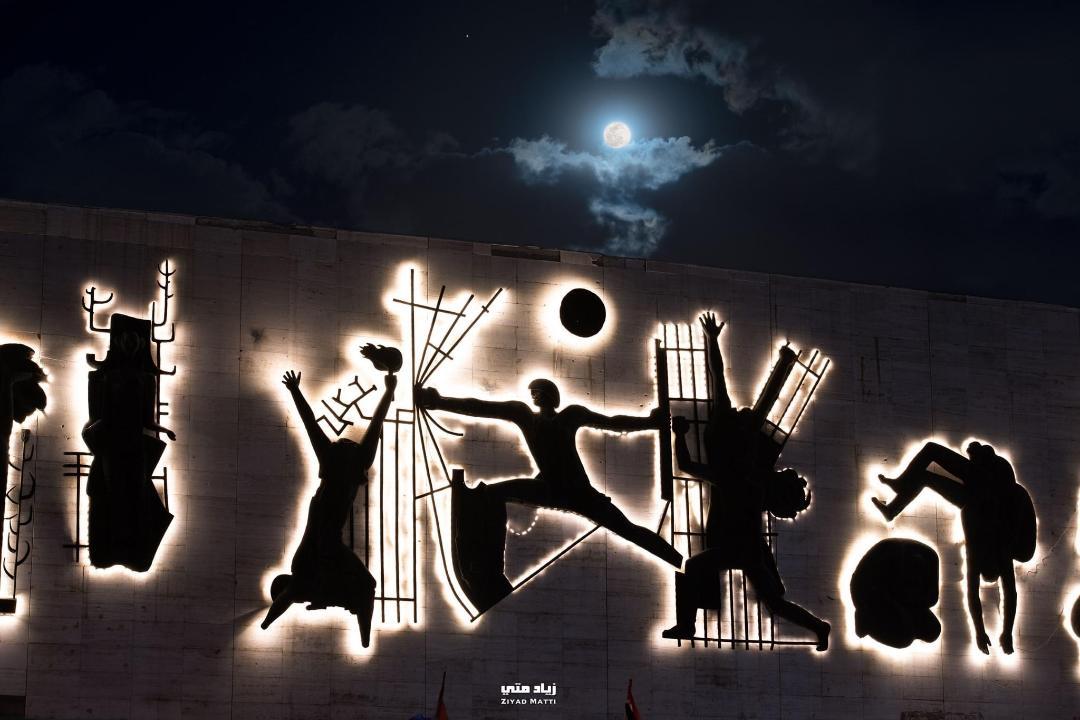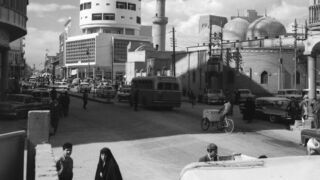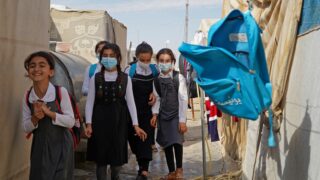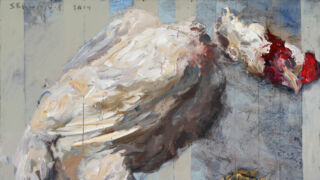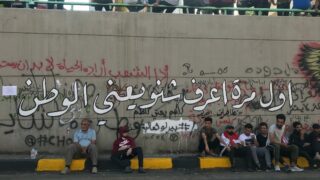
This publication has benefited from the support of the Rosa Luxemburg Foundation. This text may be reproduced in part or in full, provided the source is acknowledged.
-Hatef Farhan: “Being present in the event made me a witness, at a time when many politically affiliated groups wanted to see the truth buried in the ground. This coverage was an important lesson to me. It taught me how to control how I work under pressure.”
-Ali Dabdab: “I was introduced to a strong generation that made me feel proud of our youth and proud to be an Iraqi.” This is how Dabdab summarizes the most significant lessons he learned after taking part in the protests, both as a professional photographer and as a demonstrator.
-Ali Nader focused on showing the dangers of tear gas bombs on the one hand, and on producing journalistic stories that can reflect – in the best way possible - the lives of the protesters in the squares and their cooperation.
-Ziad Matti went to Tahrir Square armed with his long experience in capturing the aesthetics of Baghdad in photography, in all its miniscule details, even at its darkest hours when terrorist attacks had hit the city. Matti’s photographs have documented everything from rain droplets landing on the Martyrs’ bridge to the fatigued streets brought back to life by the movement of pedestrians walking through them.
-Mahmoud Raouf is especially fond of the photos in which he was able to depict the young people’s eagerness to establish a successful entity in the square, far from the ruin that encompasses everything, including his photos of the cleaning campaigns, the painting of the sidewalks, graffiti on the walls of Tahrir Tunnel, and the book corners established in several tents, among other initiatives.
-Muhammad Alaa al-Deen saw the recent demonstrations as an opportunity to show the bright aspects of Iraqis’ lives, as they cooperated and worked in solidarity with each other inside the squares, before they were besieged by the violence and the parties’ interference that aimed to sabotage and vilify the protestors.
-Ahmad al-Muhanna is the war reporter who was killed in mysterious circumstances with a bullet and a knife stab near al-Sinak Bridge. His camera, too, was found shattered by a second bullet. In fact, his camera was his close companion in both war zones and protest fields, until the very last moment of his life.
-Hatem Hashem carries the precious memories of “unexpected situations in which the sectarian and class barriers were shattered, decidedly disposing of all backward social customs and traditions.”
-Issa al-Atwani’s main concern was restoring Babylon’s identity, and his interest is observable in his work that captures the Babylonian female students marching in large numbers to support the demonstrators and lead the crowds. He considers these pictures to be among the most important ones he took during the October Revolution.
-Karrar Assaf believes that the city of Najaf was one of the pioneering rebellious governorates, and its engagement in protests had a significant meaning in terms of the city’s symbolic status, particularity, and role in the political process after 2003. Therefore, the new generation of young women and men there indicated the rise of new “actors” in Najaf, other than the usual religious and political-partisan actors. “The chronicles of the revolution were a bloodbath raised in the face of peaceful young protestors.”
-Ghazwan Baqer has many memories of those revolutionary days, but the one that shook him most was that of his encounter with an elderly woman talking to a photograph of her only son, who had been martyred in the terrible massacre of the Zaytoun Bridge in November, 2019, in the governorate of Dhi Qar.
-Hussein Faleh has lived some very difficult moments in Basra, as angry demonstrators attacked him and his co-workers, believing that they were from a government media channel, but he had to keep shooting the wounded as they cried out in pain. “Their screams echo in my head still,” he says.
-Haidar Daoud al-Rubaie saw the protests as a rare chance to witness a previously unlikely dialogue between “the youth and the elderly in the city of Basra.” Naturally, he had his concerns about continuing to photograph the demonstrations, yet he carried on, keen to represent a comprehensive picture of the Iraqi spirit that filled the squares with its exceptional vibrancy.
*****
At the time these words were written, more than a whole year has passed since the beginning of what was termed “the October Revolution”. Today, we stand before a surprising succession of social portraits that depicted values like fraternity and synergy, brought about by the young women and men who were at the forefront of the Iraqi event in all sorts of fields.
The October moment, which was met with a lot of violence and intentional defamation, can be considered one of the largest and most important protest movements in Iraqi contemporary history. We are left with hundreds of photographs from those days that provide us with the good opportunity of studying what the Iraqi photographers have produced in that revolutionary climate. In their work, one can sense a caution invited by the fact that they were working on a field which posed multiple dangers. They pursued demonstrations and documented the new faces of young protestors who were seeking a new beginning that did not resemble anything their country had known in the previous decades, in which numerous opportunities to rebuild and revive were lost.
Beside the intimidation, persecution, and threats, several of the photographers had to dodge bullets that hit their camera lenses. Many of them were forced to flee the squares temporarily or indefinitely, fearing that they might become targeted simply because they were courageously documenting the heroes of the protests and the action in the squares of ten Iraqi provinces: Baghdad, Nasiriyah, Basra, Karbala, Najaf, Wasit, Babel, Samawah, Diwaniyah and Maysan.
Here are the testimonies of a number of these photographers, each shared with a photograph of their selection.
*****
Hatef Farhan: In between sides
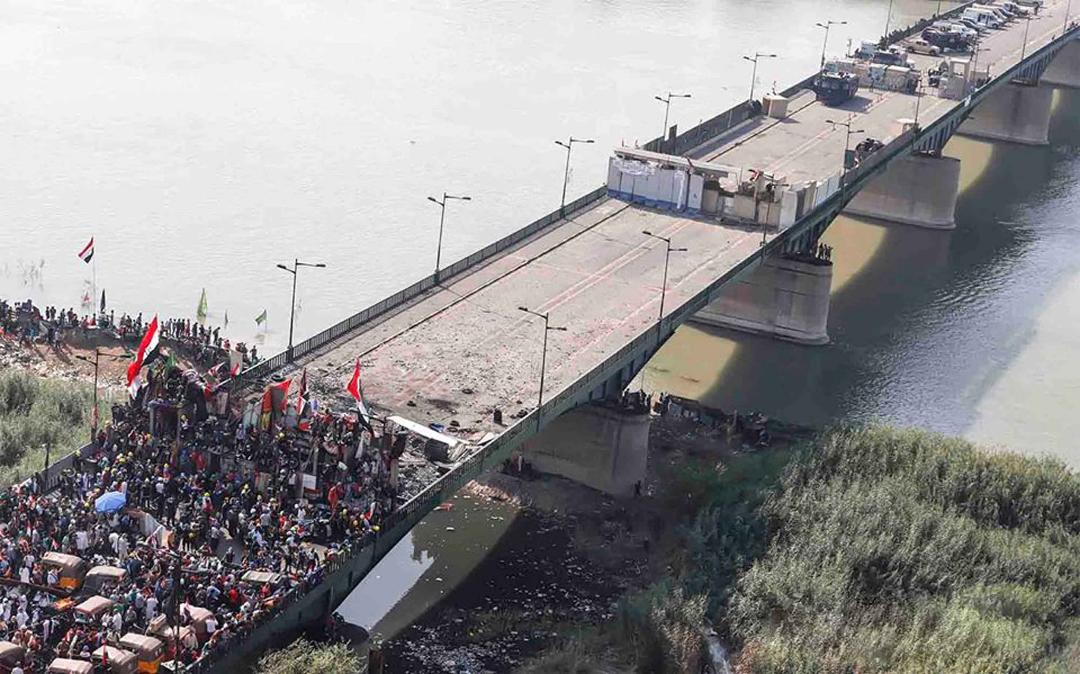
Farhan is one of Baghdad’s most prominent photographers. He was one of the first who took to Tahrir Square in a mission he describes as “a rich experience which has taught me a lot,” because, to him, “being present in the event makes me a witness at a time when many people wished for the truth to be buried. This was a significant lesson to me, in addition to my learning how to control how I work under pressure.”
The photograph he holds dearest to his heart is that in which the demonstrators gather on one side of a bridge while the security forces huddle on the other end, showing the symbolism that sums up their entire relationship, with the distance in between making up the gap between what the protestors demand on the one hand, and the intransigence of the authorities on the other hand.
“The October demonstrations are a significant historical turn and a precedent in the country’s history, at the level of the number of participants and the longevity of the overall movement.” Farhan says that “everything that was happening around the movement was of great importance,” especially after the demonstrations turned into an open sit-in, which included relevant cultural/artistic initiatives.
Ali Dabdab: A great adventure
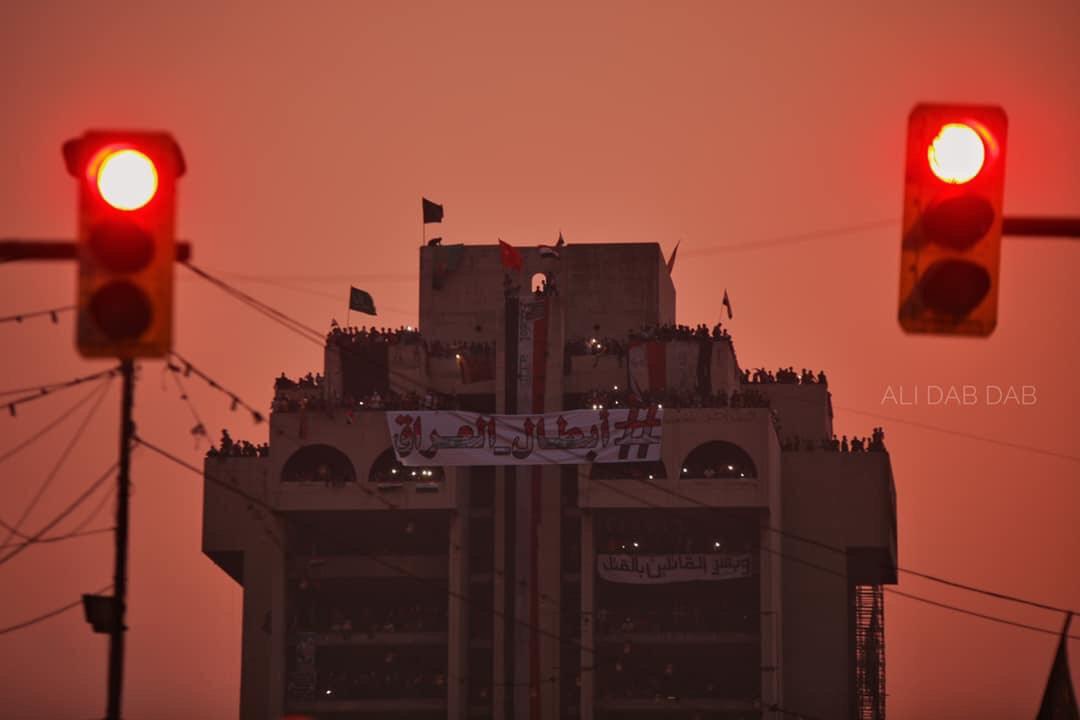
Ali Dabdab was one of those who performed the double mission of being a photographer and a protestor at once. Dabdab was at the frontline where the clashes were most intense, and his camera shot images of the mouths of rifles that circled the squares, as well as the moments of the young people’s courageous perseverance in Tahrir Square. He, acting as both a protestor and a photographer, moved from corner to tent, and from tent to street, covering action in the squares of protest.
Dabdab is one of the photographers whose pictures received exceptional attention in the demonstrations. He describes his visual production as a “great adventure” in which he won the confidence of many as a reliable reporter at a time when rumors and misinformation reigned.
“During that time, I was introduced to a strong generation that made me feel proud to be an Iraqi and inspired by our promising youth.” This is how Dabdab summarizes the impact that the protests had on him.
The most difficult moment he had experienced during those days was when his colleague, photographer Ahmad al-Muhanna, was martyred in what he called the “Sinak massacre”. “After the (political) parties interfered and violently suppressed the demonstrators that night, I promised Ahmad that I would complete the mission he started,” he says.
Dabdab received several threats, the first of which was sent by anonymous persons. As a result, he and his family had to flee Iraq in October 2019, yet Dabdab returned soon afterwards to Baghdad – by himself – and resumed his work in the demonstrations. During that time, he survived four life-threatening injuries, some of his photographic equipment was destroyed, and he was also bruised in different parts of his body. Shortly afterwards, Dabdab received a final threat from within the square, and thus found himself obliged to discontinue his presence there.
Ali Dabdab is proud of every single one of his photographs, because each of them was a challenge, posing the possible risk of injury or death. He was always preoccupied, trying to reveal the unseen details and layers of the demonstrations, showing a humanitarian dimension in his “eloquent images that carry a message that needs neither captions nor explanations,” that is, despite the individual mishaps and mistakes that tainted the movement at times, which were exploited for negative propaganda by the polarized media platforms.
Ali Nader: Stories about bombs

Ali Nader has been photographing the movement since the night of October 25, 2019. “That was the most difficult night. I was in the Turkish restaurant on the 13th floor of a building, trying to document everything I saw in stills and video: the tear gas, pepper sprays, and bullets. The scariest moment was when a tear gas canister landed right next to me and almost smashed my foot,” Nader says as he recalls his early experiences during the demonstrations.
On the 24th of January, 2020, Nader was injured while he was filming the upheaval and the street blocking near the Gilani fuel station, as he was trying to protect a boy from the riot police. He ended up in Al-Kindi Hospital after having fainted from several blows to the head.
In his photographs of the “October Revolution”, Nader focused on showing the dangers of tear gas bombs on the one hand, and on producing journalistic stories that can reflect – in the best way possible - the lives of the protesters in the squares and their cooperation.
Ziad Matti: The eloquence of the image

The work of Ziad Matti is marked by its ability to create “iconic” images of places, faces, and emotional states. He has intelligently captured the aesthetics of Baghdad, in all its miniscule details, even at its darkest hours when terrorist attacks had hit the city. Matti’s photographs have documented everything from rain droplets landing on the Martyrs’ bridge to the fatigued streets brought back to life by the movement of pedestrians walking through them.
With his energy and positivity, Matti headed to Tahrir Square, to declare his clear stance there through the hundreds of photos he took. His camera accompanied the youth of the revolution, and each of his photographs spoke with the visual eloquence of the scenes he captured: the face of a paramedic among the wounded protesters, a tilted flag hanging on the back of a young man, the words “We want a homeland” written in the snow that covers the sit-in tent in the middle of Tahrir Square, and many other powerful scenes that bear both the paradoxes and the intimacies of the moments they reflect.
Mahmoud Raouf: Photos for hope
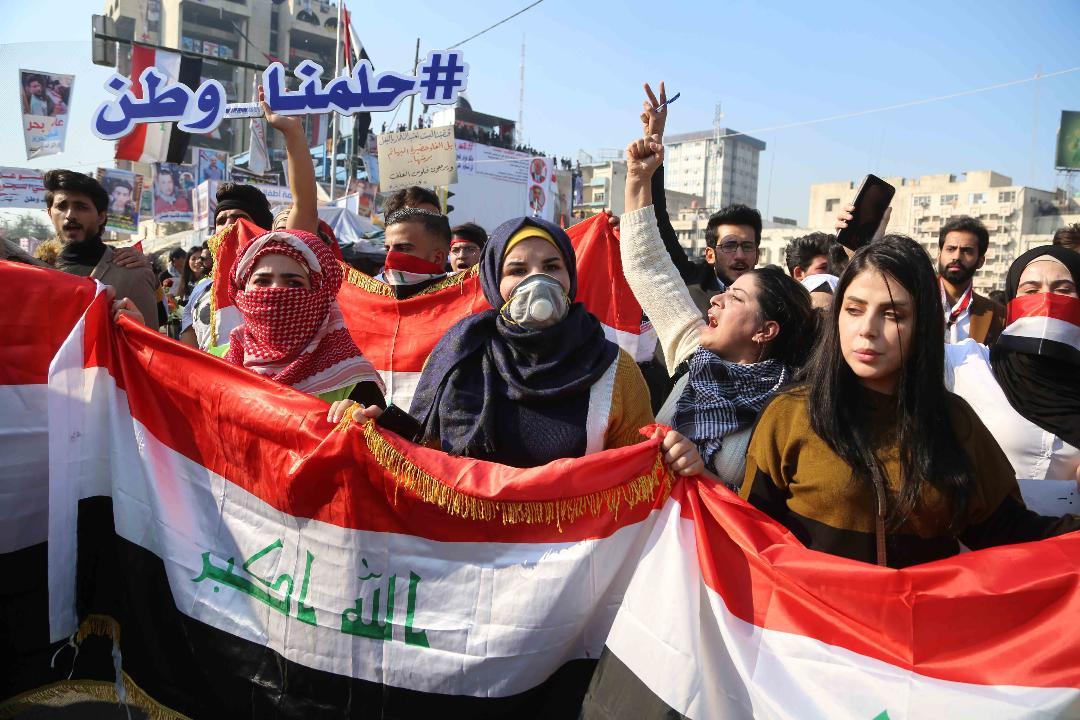
Mahmoud Raouf is from that generation that had built up experience since 2003, covering and documenting all kinds of events in Iraq with his camera. He found in the young October revolution something fresh that renewed his hope in his country. The most difficult memory he has of the events was when his attempt to capture a special photograph of a group of young demonstrators turned into a horrific experience as a tear gas canister penetrated the head of one of them. Raouf’s screams at the scene were only amplified by the torrent of gas bombs that kept falling in front of his eyes, hitting and injuring several other young men.
His desire to capture movement and colors is evident in his photographic body of work, such as the shots of cheering demonstrators, their facial expressions, and the slogans and banners they carried over their heads. Raouf also tried to show the Iraqi flag’s waving cloth as though it were a structural, integrated part of the protest’s overall movement.
His favorite photographs are those that depicted the young people’s eagerness to establish a successful entity in the square, far from the ruin that encompasses everything, including photos of cleaning campaigns, painting sidewalks, graffiti on the walls of Tahrir Tunnel, book corners in several tents, among other initiatives.
After various warnings from the security forces who threatened to arrest him if he continued to cover the demonstrations, Mahmoud Raouf was detained for one day and then released. He had also been hit by a tear gas canister that caused him back injuries. To escape the daily harassment and persecution, Raouf had to constantly change his route of access into Tahrir Square, which allowed him to cover the grand event for months on end.
Muhammad Alaa al-Deen: People in solidarity
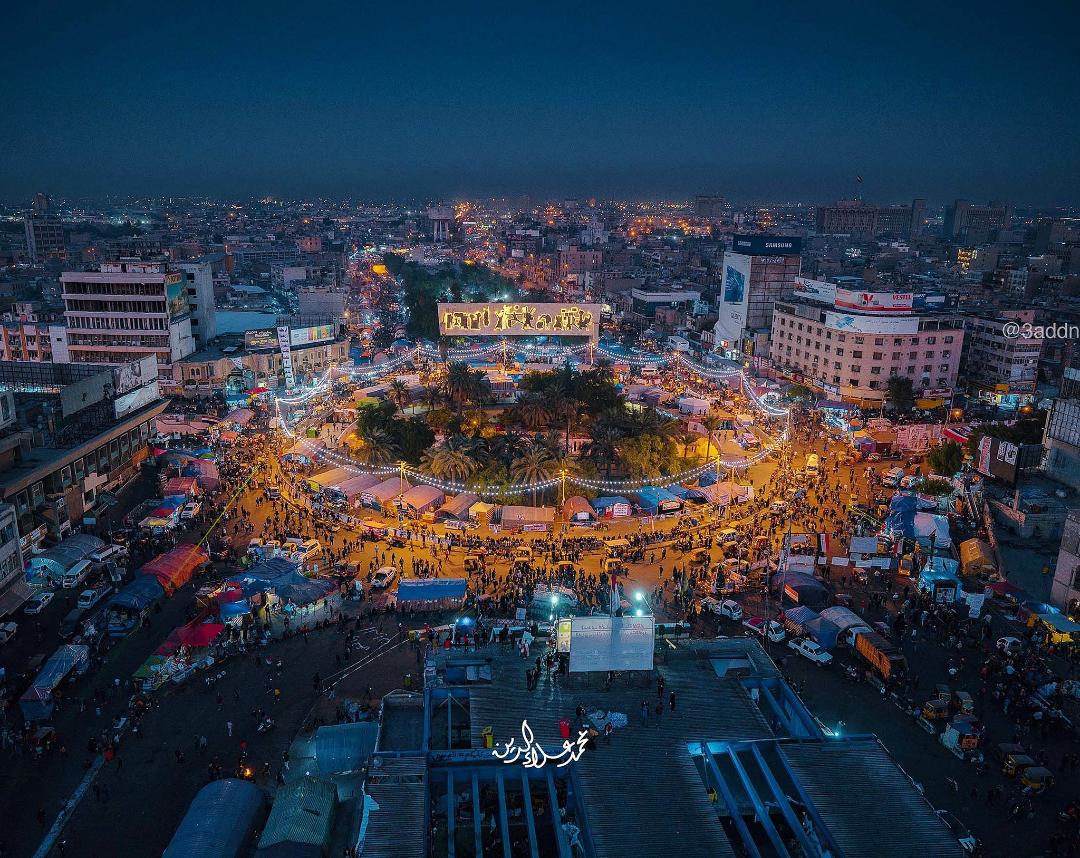
Since 2008, Alaa al-Deen has been interested in presenting multiple aspects of Baghdadi life. He has shared his photographic experience on social media platforms. For him, the recent demonstrations were an opportunity to show the bright aspects of Iraqis’ lives, as they cooperated and worked in solidarity with each other inside the squares, before they were besieged by the violence and the parties’ interference that aimed to sabotage and vilify the protests.
Alaa al-Deen recognizes the dangers of being present in Tahrir Square at that time, as he recalls that in one incident, it was luck alone that had saved him from getting kidnapped late at night while he was leaving the square, not to mention the many other threats he had received on a regular basis on his social media platforms, sent by those who doubted the movement and its intentions.
Alaa al-Deen does not limit his work to a specific topic. Rather, he scans the field and finds in the daily routines of the demonstrations scenes and situations that are worth documenting with a camera. The most important thing for him was to produce photographs that are capable of showing the spontaneity of the youth and the ways through which they make their true demands heard, amid campaigns that incessantly worked on defacing the peaceful protestors by accusing them of riots and vandalism.
Ahmad al-Muhanna: A bullet and a knife-stab
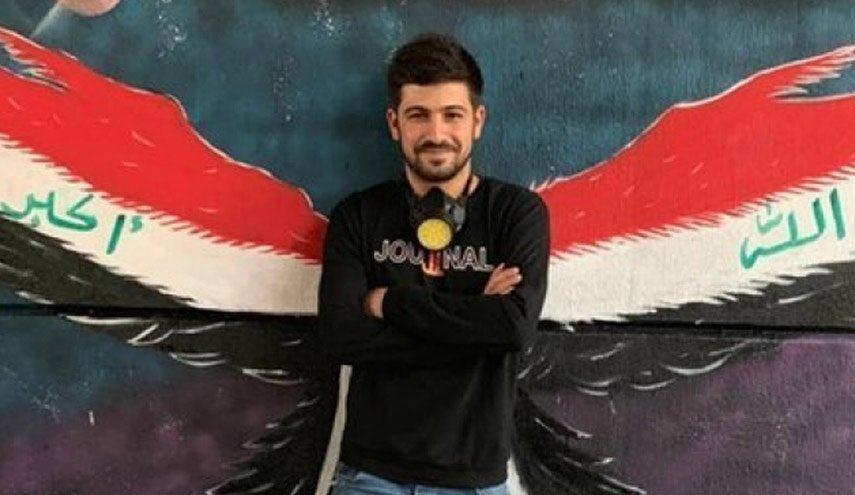
From the war zones of the fights against ISIS to covering the action in Tahrir Square, Ahmad al-Muhanna left the bullet proof vest he usually wore when covering war, to roam freely in the sit-in square which eventually sealed his fate. Al-Muhanna was shot by the bullets he had always avoided throughout his career, and his camera was his close companion in both war zones and protest fields, until the very last moment of his life.
Al-Muhanna is a war photographer who had accompanied the security forces and the Popular Mobilization Forces (PMF) during the battles against ISIS. He wanted to be present in the demonstrations as well, so he took to the square and pointed his camera at the humane scenes in Tahrir. On the ominous day of December 6, 2019, the demonstrators were attacked by armed groups and bullets were fired near the al-Sinak Bridge, where Ahmad was killed in mysterious circumstances with a bullet and a knife stab. His camera, too, was found shattered by a second bullet.
Hatem Hashem: Breaking down barriers

Hashem believes that documenting the October Revolution was riskier to him as a photographer than covering the battles of liberation against ISIS years ago. “I knew how to protect myself during those battles, but in the revolution you don’t really know who you’re facing or where the bullets and bombs are coming from,” Hashem says.
Near the pillars of al-Rasheed, the most beautiful street in Baghdad, Hashem lived his most difficult moment during the revolution, where he encountered a young man who was badly wounded by the riot police. Hatem was unable to continue shooting, and he stopped to help save the boy who was struggling to stay alive amid the downpour of bullets and bombs.
The series of threats did not exclude Hatem Hashem either. However, he was subjected to intimidations of a different nature, which included job offers from political parties (hinting that taking a job with them would be far safer for him than the coverage he was doing in the squares!), in addition to the anonymous warnings he received on social media, followed by a direct threat, and even being stalked outside the sit-in square.
Hashem carries the precious memories of “unexpected situations in which the sectarian and class barriers were shattered, decidedly disposing of all backward social customs and traditions.” The most prominent of those moments, in his opinion, was when the Iraqi team beat the Iranian one in the football match that was screened in Tahrir Square. He adds that “the demonstrators turned that victory into a ceremonial festival which was not deterred by the tear gas bombs that kept falling over their heads throughout the joyous celebrations. All the people of Baghdad took to the streets that night and took part in the event!”
His favorite scene was that of the young demonstrators in Abu Nawas Street at night, pointing their “green laser” beams at the riot police to hinder them from throwing bombs. The web of light that resulted from their collective act is engraved in his memory.
Hashem’s photographs are a mélange of emotions, actions, and unexpected reactions that brewed in a place that reflected bizarre general structures. It was a square whose corners were furnished by the enthusiastic initiatives of the young people, and whose streets were filled by the sheer peculiarity of the Iraqi reality with its many contradictions. It was where a group of young people would pick up bombs and put them away at one moment, only to turn away from the face of danger to play a game of football in the street the next moment, or to express their immediate joy by dancing or clapping…
Issa al-Atwani: Babylon reclaims its identity
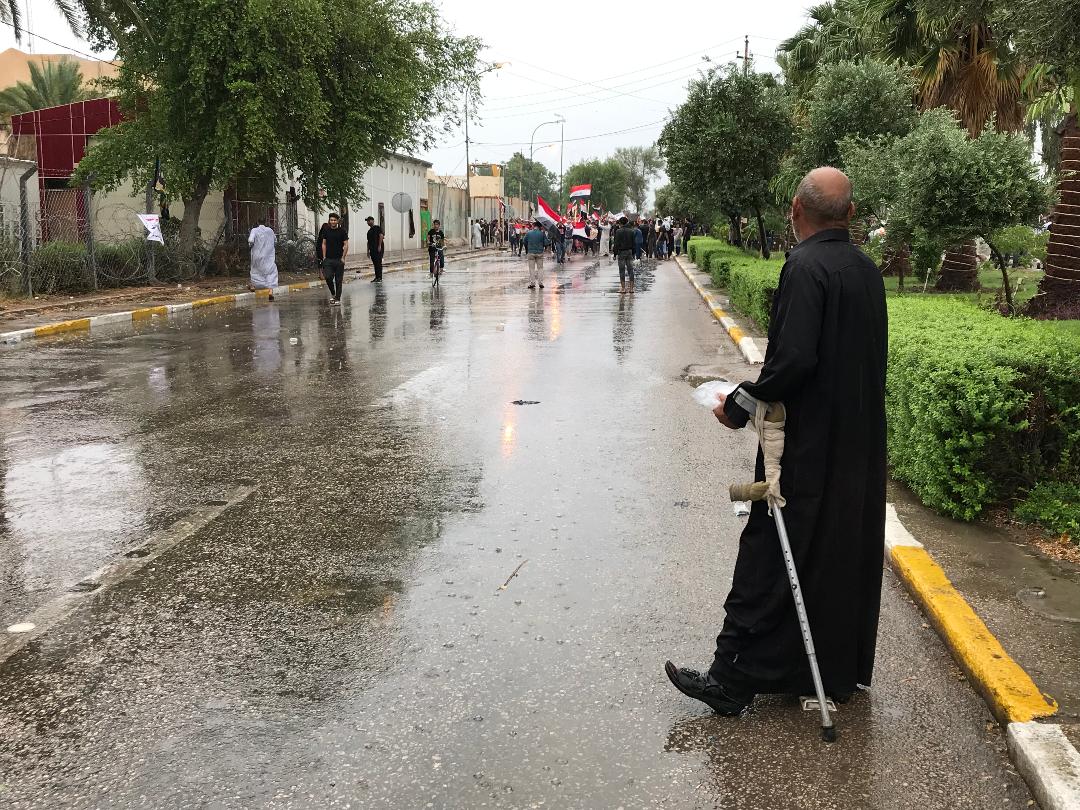
Babylon Governorate is a great symbolic presence in the general scene regarding the demonstrations, as it represents the “fractured present in today's Iraq.” Its cultural identity had been compromised, almost lost and forgotten, until the protests came not only to object to the failure of the state, but also to defend the suffocated civil and cultural nature of Babylon.
Therefore, according to the photographer Issa al-Atwani, the people of Babylon going out in protest against mismanagement and the lack of justice was “a joyful scene that calls for pride in this great awakening of the people.”
Al-Atwani, too, faced various violent incidents during his coverage in his governorate. His camera was destroyed, and he and other journalists were battered by the security forces. He was also threatened by fake Facebook accounts and directly in offline situations, to the point that he was forced to stop covering the daily events of the protests.
Al-Atwani’s concern with restoring the city’s identity is observable in his work that captures the Babylonian female students marching in large numbers to support the demonstrators and lead the crowds. He considers these pictures to be among the most important ones depicting the October Revolution, because “women were finally able to represent themselves there in a completely new way, after having suffered various forms of persecution in Iraq. The unbridled emergence of their voices, along with their breaking of social restrictions were indeed a great victory for all Iraqi women.”
Al-Atwani was keen to show the “momentum of the revolution, in terms of the numbers of participants, especially that the protesters had faced numerous campaigns that aimed to belittle their popular presence.” He also focused on taking shots of “spontaneous moments that revealed the honorable and pure nature of the demonstrations.”
Karrar Assaf: New actors in Najaf
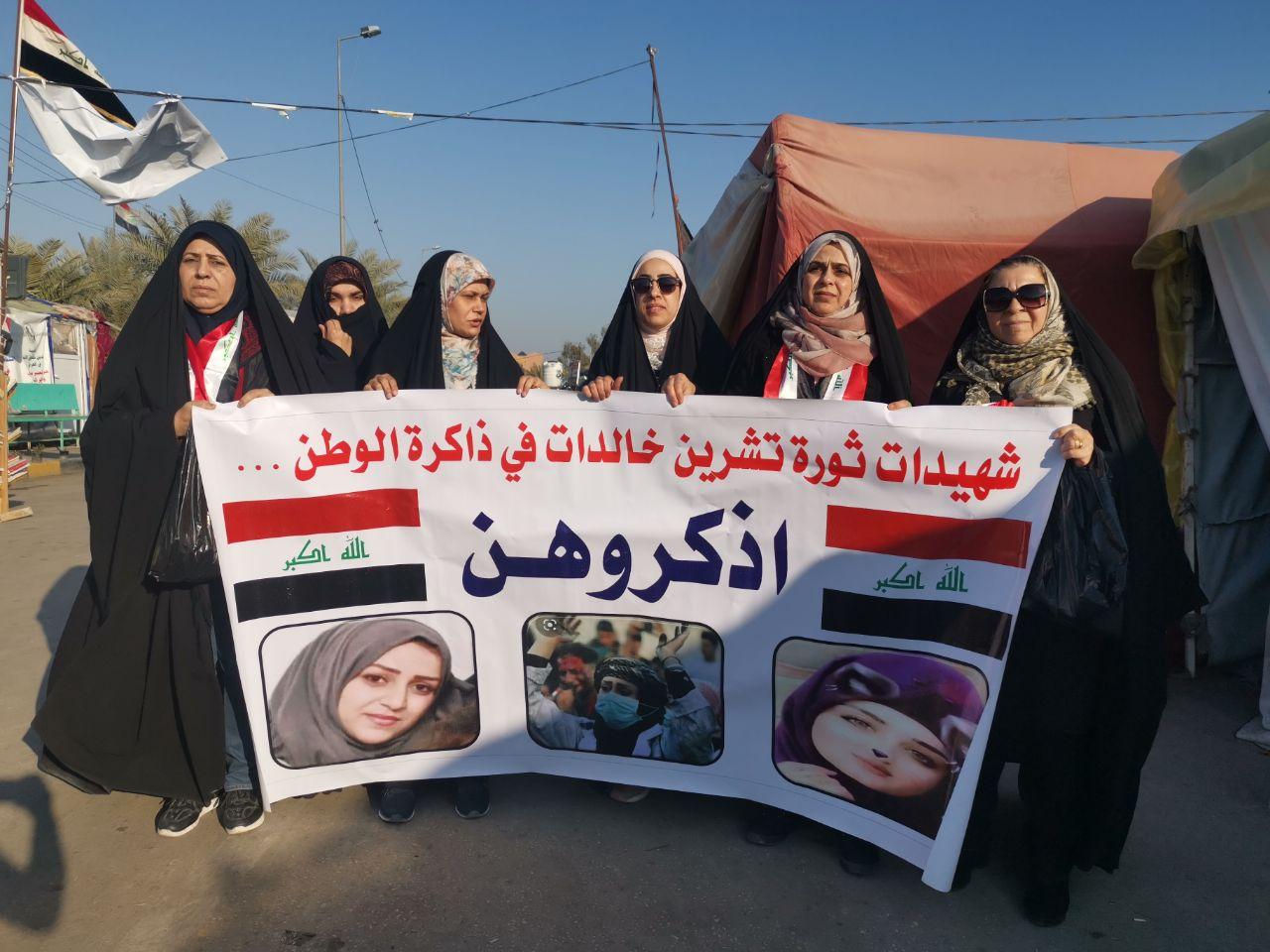
The city of Najaf was one of the pioneering rebellious governorates, and its engagement in protests had a significant meaning in terms of the city’s symbolic status, particularity, and its role in the political process after 2003. Therefore, the new generation of young women and men who participated in demonstrating indicated the rise of new “actors” in Najaf, other than the usual religious and political-partisan actors.
Karrar Assaf’s mission in this context was directly linked to this development in the Najaf environment. For him, the protest movement is “a school where every professional can leave a mark in the square, and an opportunity for the photojournalist to train his eye to observe as many humane images as he can at a time when humanity as a moral quality has become scarce.”
Assaf was impressed by the unprecedented patriotic drive of the young people, whose persistence and courage grew bigger every time a martyr fell in their midst, and he was inspired by the role the women, young and old, had played in the event.
The Najafi photographer admits that he, too, has received his fair share of direct and indirect threats, which did not deter him from persevering in documenting the demonstrations.
“The chronicles of the revolution were a bloodbath raised against peaceful young protestors!” With this phrase, Assaf concludes his description of his six-months experience of documenting the Najaf sit-in.
Ghazwan Baqer: The conversations at Zaitoun Bridge in Nasiriyah

As soon as the names of Dhi Qar and its center, Nasiriyah, are mentioned, one cannot but recall the legendary steadfastness and the unique sit-in of the youth in al-Habboubi Square. Nasiriyah inspired hordes of journalists and photographers, whose patriotic feelings were stirred by this social leap, leading them to assume the great responsibility of covering all aspects of its protests.
Baqer has many memories of those days, but the one that shook him most was that of his encounter with an elderly woman talking to a picture of her only son who had been martyred in the terrible massacre of the Zaytoun Bridge in November, 2019.
Baqer took several measures and precautions to circumvent being targeted in the square, including using his mobile phone camera to avoid attention when shooting.
Nevertheless, he still received warnings of potential threats to anyone who supported the demonstrations through media coverage, but he was never discouraged to continue.
Baqer says that during his six months of coverage, he has concluded that “the candid image was the main substance” of his work.
Hussein Faleh: The pains of Ahmad Abdul Samad and his comrades in Basra
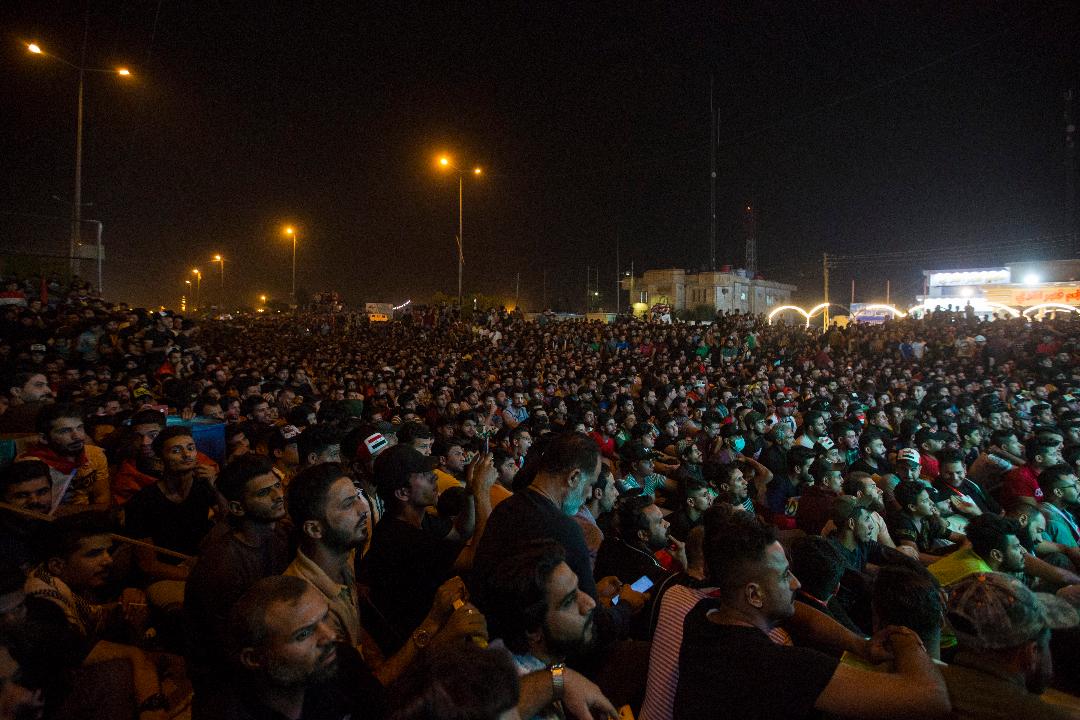
“I took the picture above on November 14, 2019, in Basra. It shows protesters watching a football match that took place in Amman between the Iraqi football team and its Iranian counterpart, on large screens set up in the protest square of the city. That night, the Iraqi national team’s victory turned into an enormous national celebration!”
Basra: the Song of the Marooned Fisherman
30-09-2015
Basra has a remarkable history of protest. It is where the first sparks of the 2015 demonstrations were ignited, and in 2019, it was one of the pillars of the youth revolution. Many confrontations took place in Basra and a number of activists were attacked. For photographer Hussein Faleh “filming the protests is a very heavy task that needs particular courage and strength, especially when clashes break out between the security forces and the protesters.” He adds that “it is especially difficult to manage to get journalistic photographs when in danger, so the entire experience taught me a lot about concentration and speed when shooting photos.”
Faleh had gone through an intense day when he had painstakingly filmed the clashes in the city of Umm Qasr. He lived difficult moments there, as angry demonstrators attacked him and his co-workers, believing that they were from a government media channel. Nevertheless, he had to keep shooting the wounded, even as they cried out in pain. “Their screams echo in my head still,” he says.
The assassination of the journalist Ahmad Abdel Samad and his cameraman, Safaa Ghali, in Basra in early 2020, alarmed all their colleagues who worked in the governorate, including Faleh, who was deeply saddened by his colleagues’ tragic murders.
The Basra-born-and-raised photographer cherishes a particular photo he took of a protester who placed his palm on the camera’s lens, trying to prevent Faleh from shooting. The photo is one of a kind, because it was taken on a rainy day with a lens unfit for photojournalism, yet it illustrates well the struggles that a photographer has to deal with when covering an event.
Faleh’s main concern is that he be able to produce photographs which are not repetitive; different from what his colleagues have produced in the same field.
Haidar Daoud al-Rubaie: Basra’s character
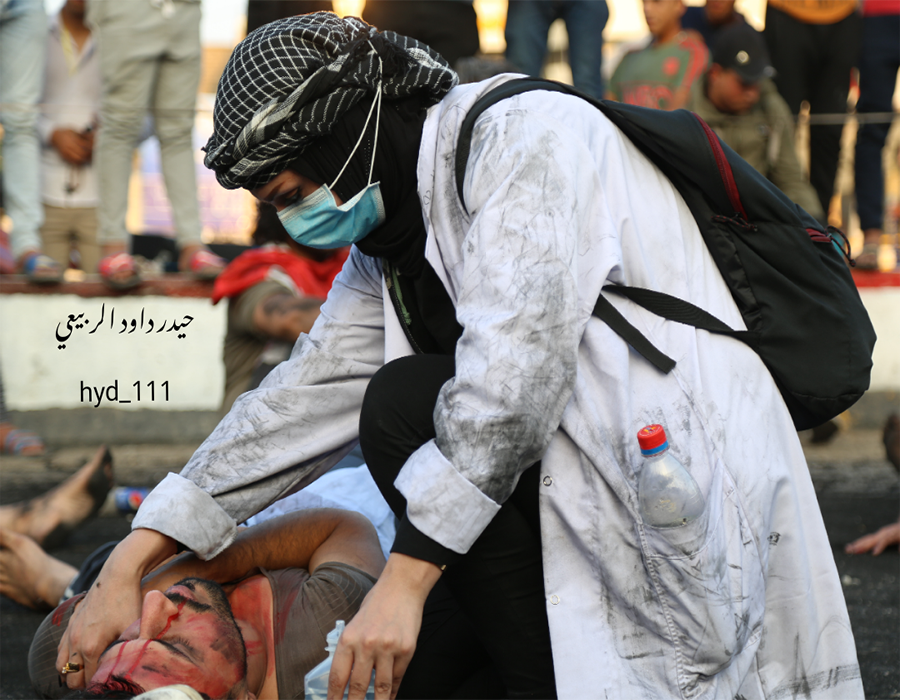
Al-Rubaie had the opportunity to discover - during his coverage of the demonstrations - the latent abilities, knowledge, and values he didn’t know existed in the young people of his governorate, Basra.
The protest movement presented this Basra photographer with the exciting chance to witness a previously unlikely dialogue between “the youth and the elderly in the city.” Naturally, he had his concerns about continuing to photograph the demonstrations, yet he carried on, keen to disseminate a comprehensive picture of the Iraqi spirit that fills the squares with its exceptional vibrancy.
“The most telling photograph of mine is the one in which I am standing among the demonstrators as one of them, wishing only to cover the truth, despite all the malicious infiltrators who had tried time after time to vilify our movement,” al-Rubaie says, describing the photo he holds dearest to his heart.
The content of this publication is the sole responsibility of Assafir Al-Arabi and Rosa Luxemburg Foundation cannot accept any liability for it.
Translated from Arabic by Sabah Jalloul
Published in Assafir Al-Arabi on 03/12/2020

